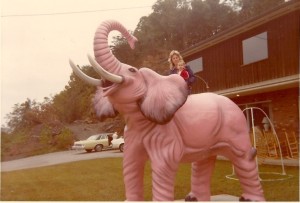My grandparents are gone, the property’s sold, but the elephant abides.
In the 70s, my grandparents owned Taylors Furniture and Gifts, a small shop in a two-story building my grandfather built. Huge windows faced the highway. In good weather, Nana lined up rockers and swings out front.
I recently found a business card touting their Gifts, Wicker & Rattan Furniture, Rockers, Ladderback Chairs, Barrels, West Virginia Glass, and unspecified “Mexican Items.”
Mostly I remember the store through Nana’s left-behind collection of photographs and newspaper clippings.
And the artifacts (think wicker monkeys and Fostoria glass) that still circulate in the family.
And the elephant.
 Papa Taylor bought a pink elephant statue in Michigan, an animal nearly ten feet high to the top of his regal fiberglass head. Papa brought it back to West Virginia and parked it in the small square of lawn in front of the store. He faced that elephant toward U.S. Route 60, a busy two-lane then that’s swelled to four plus a turning lane now. The animal’s uplifted trunk curls behind him, as if to spray his dusty back, his riders, or the store with imaginary water.
Papa Taylor bought a pink elephant statue in Michigan, an animal nearly ten feet high to the top of his regal fiberglass head. Papa brought it back to West Virginia and parked it in the small square of lawn in front of the store. He faced that elephant toward U.S. Route 60, a busy two-lane then that’s swelled to four plus a turning lane now. The animal’s uplifted trunk curls behind him, as if to spray his dusty back, his riders, or the store with imaginary water.
Papa gambled that such an unexpected creature would make people stop for a photo, and then stick around to buy a fetching coffee table or a trash can shaped like a frog.The pink elephant is the spirit animal of that stretch of highway lined with grocery stores, car lots, pawn shops, strip malls, and fast food restaurants. On a nicer road, the elephant would be an eyesore. But there, he blends right in, an eccentric neighbor who causes a double take before he wins you over. He’s a non-native species that’s an emblem of our small town.
Papa and Nana printed the pink elephant on their business checks and collected pink elephant knickknacks in the house. For years after my grandfather died, my mom would find a token pink elephant for Nana at Christmas: a pendant, a statue, a tea towel. In the last days of her life, as she lay in bed in hospice, Nana slept with a plush pink elephant tucked under one arm.
My grandparents lived near the store, in the last house that Papa ever built, a split-level perched above the highway. We lived on a road down the hill from them, a road that Nana called a “holler,” as in “how are things up the holler?”
Our holler was close, claustrophobic, leafy in the summer, a handy place to store your shadows. In a holler, you’re tucked into the hills and most of the mailboxes bear the same last name. You learn not to look at the Christmas lights unless you’re in the passenger seat. You learn the curves and gamble sometimes on what’s around the bend. Could be fog, could be wind, could be nothing.
The pink elephant was a handy landmark so friends and pizza delivery people could find us. We weren’t far from Rt. 60, but you had to know where turn. The holler didn’t draw attention to itself which was part of its charm.
Now I live in the Pacific Northwest, far from my native holler and its attending elephant. With no tattoos, I feel a bit naked in this part of the world. I’ve thought about getting one of a stylized pink elephant, an elephant as it might look if it sauntered out of illuminated manuscript or a cathedral window. The ink would mark where I’m from.
“What does it mean?” People always ask that about tattoos. I could say that it represents that tall, hollow elephant on Rt. 60. It reminds me of grown-ups climbing ladders and hoisting up grandchildren to sit on the elephant for photos because it’s our birthright.
I could remind them that the pink elephant means starry visions when you’re in an altered state.
Pink elephants, the internet assures me, do exist. Behold the albino elephant, available in white or pink. And, affirms the internet, the pink elephant stands for what a charmed childhood and a badass tattoo must always be: “something extraordinary.”

Nicole’s work has appeared in Image, Mid-American Review, Hotel Amerika, DIAGRAM, Sonora Review, The Ocean State Review, Western Humanities Review, Tampa Review, Quarterly West, North Dakota Quarterly, and in Permanent Vacation (Bona Fide Books, 2011) and Jesus Girls: True Tales of Growing Up Female and Evangelical (Cascade Press, 2009) and elsewhere. She is an assistant professor of English at Whitworth University in Spokane, Washington, and the web editor for Rock & Sling and How to Pack for Church Camp, an online anthology of creative nonfiction about summer camp. She is on the Twitters at @heynicolesheets.